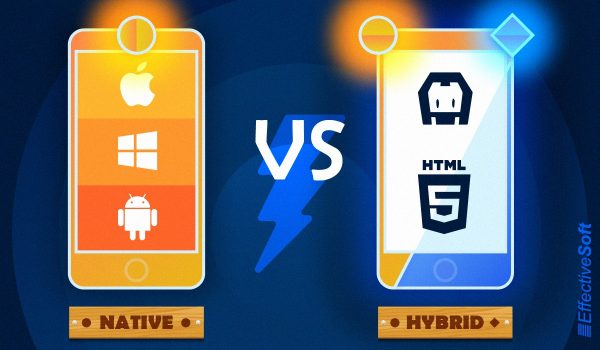By Yana Yelina
The popularity of mobile software usage is immense, and the statistics prove this assumption. As of March 2017, Google Play comprised 2.8 million apps and 2.2 billion were available on the Apple Store. Moreover, apps fall at 89% of mobile media time (with just 11% spent on websites).
Nevertheless, it’s not always an easy task to choose the right mobile apps developer to obtain an optimal solution that will attract thousands of users. Before making a final decision, you should certainly ask your potential vendor to provide case studies and testimonials to make sure you are dealing with a true professional.
Before delving into tiny technical details, you are to learn some basics of mobile software development and understand whether you would like to get a native/web/hybrid app in the end. To understand which approach suits you most, it’s crucial to have a look at the existing pros and cons and find the desired perks.
Native apps
They are developed specifically for a given mobile platform (iOS or Android) with the usage of relevant tools and languages (Xcode/Objective-C for iOS; Java/Eclipse for Android). Before choosing this approach, customers should consider the following pros and cons.
Pros:
a smooth run: the beauty of such apps is that they are designed according to the guidelines of a given operational system, so they are more refined than their hybrid rivals and they run faster and with less bugs;
- an easy use: mobile users are accustomed to the native platform, and when your vendor adds all those familiar features the app becomes easier to use;
- improved access to inherent capabilities: native solutions tap into the whole device functionality (camera, GPS, microphone, and more) without problems, while hybrid apps provide only restricted access to them;
- higher security: considering the fact that these apps should win the approval of the store they are tailored for, your future users will be able to relish greater security and excellent support;
- better UX: users are accustomed to native apps interface components granting developers an exciting opportunity to build meaningful transitions and transformations. Beyond that, better UX means higher engagement among users and greater popularity.
Cons:
- high cost: native apps are more difficult to develop, so bear in mind that you’ll have to allocate a generous budget; furthermore, the cost may be even greater if you desire your mobile software to function on iOS 7, Android, and Windows, as your vendor will be engaged in the development of three different programs and each of them should be properly tested;
- a longer process: mind the fact that it will take much more time to develop and test a native app, and this process can be slowed down by store approval procedures.
To sum it up, vote for native solutions if you are determined to have a high-quality consumer-focused resource where high performance and graphics are crucial (a good fit for mobile games).
Hybrid apps
A hybrid app combines native and web (HTML5) worlds. It is cross-platform and can be distributed without delays (developers are released from the necessity to create separate versions: Android/iOS/Windows Phone).
Here are major advantages and disadvantages comprised by such apps.
Pros:
- faster development speed: the creation of hybrid apps involves cross-compatible web technologies (CSS, HTML5, JavaScript, etc.) before being put in a native platform, which increases the speed of the development process and allows to reach the market sooner;
- cost efficiency: the overall cost of hybrid apps development and maintenance is much lower compared to that of native apps, which may be a significant perk for those who have a tight budget;
- BYOD program compliance: if you plan to use the solution within the company as part of your corporate culture, make sure to give preference to hybrid apps because they work across various devices and successfully address compatibility challenges. If you decide to put a BYOD program in practice, your employees won’t have any problems while accessing the app;
- change-friendly: it’s a wise idea to choose a hybrid app if you constantly ask to add a wide range of slight changes to the solution when it has already been released. You just ask your vendor to add the update on the store page that is loaded from the server, and users will immediately get the update.
Cons:
- poor UX: one of the most obvious disadvantages of this option is the lack of full native-like experience. And taking into account the fact that users are not willing to give an app many tries, devote scrupulous attention to this aspect;
- disappointing performance: as a rule, hybrid apps are slower, less sophisticated, and their users may face frequent lags. In addition, they can’t boast the same graphical performance as their native counterparts;
- lax security: hybrid apps are built for multiple platforms, so they don’t adhere to the needed functional and security guidelines. As a result, such apps lack security.
This article has featured major pros and cons of choosing between native and hybrid apps. They will certainly become a valuable source of information for customers who are sure about their main purpose but have some doubt over the perks they will finally get.
Yana Yelina is a Tech Journalist at www.effectivesoft.com, a custom software development company with 250+ specialists who boast expertise in different business domains (healthcare, social media, trading and finance, logistics, e-commerce, etc.). You can reach Yana at: yanina.yelina@gmail.com, find her on Facebook, connect via LinkedIn or Twitter.







